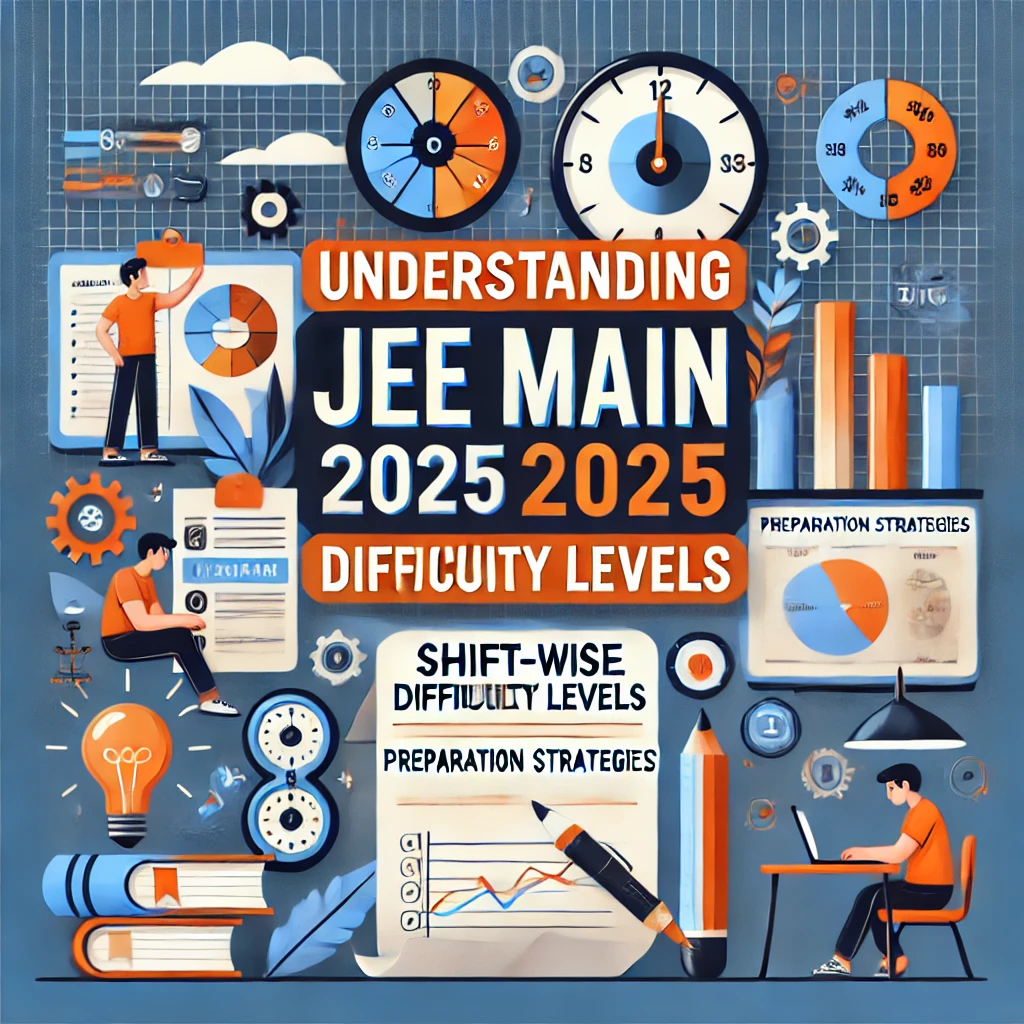The Joint Entrance Examination (JEE) Main is one of the most competitive exams in India, and understanding the difficulty levels of different shifts is crucial for aspirants. This blog provides a comprehensive analysis of the JEE Main 2025 shift-wise difficulty levels, preparation strategies, and insights into percentile predictions. Whether you’ve already attempted the exam or are preparing for the April attempt, this guide will help you navigate your preparation effectively.
JEE Main 2024: Shift-Wise Difficulty Analysis
How Was the Difficulty Level Calculated?
The difficulty level of each shift was determined using a data-driven approach:
- Teacher Inputs: Educators analyzed each question to assess its complexity.
- eSaral’s Marks vs Percentile Tool: Data from over 1.5 lakh students was compiled and analyzed using AI to evaluate the toughness of each shift.
- Student Feedback: Post-exam, feedback was collected from at least 20 students per shift to understand their experience and challenges.
This combined analysis helped rank the shifts from the toughest to the easiest, providing aspirants with a clear understanding of their performance and percentile predictions.
Key Factors Influencing Difficulty Levels
1. Pattern Changes in JEE Main 2024
This year, the exam pattern underwent significant changes:
- The total number of questions was reduced from 90 to 75.
- Negative marking was introduced, increasing the risk of losing marks for incorrect answers.
- These changes made the exam more challenging, impacting overall percentiles and cut-offs.
2. Subject-Wise Difficulty
The difficulty level varied across subjects (Physics, Chemistry, and Mathematics) in different shifts:
- Mathematics: Consistently tough across all shifts.
- Physics: Ranged from moderate to tough.
- Chemistry: Mostly moderate but included unexpected and tricky questions in some shifts.
Shift-Wise Breakdown: Toughest to Easiest
1. 28th January Morning Shift
- Overall Difficulty: Toughest
- Reason: Advanced-level questions in all three subjects. Mathematics was exceptionally challenging, leading to fewer attempts by even high-scoring students.
- Impact: Students who scored 180-190 in previous years struggled to cross 120-130 in this shift.
2. 23rd January Morning Shift
- Overall Difficulty: Very Tough
- Reason: Physics was tougher than usual, and Chemistry had unexpected questions. This shift required strong conceptual clarity and time management.
3. 24th January Morning Shift
- Overall Difficulty: Tough
- Reason: Mathematics was super tough, while Physics and Chemistry were moderate. This shift demanded exceptional problem-solving skills.
4. 28th January Evening Shift
- Overall Difficulty: Tough
- Reason: Psychological pressure from the morning shift’s difficulty affected students. Chemistry was moderate, but Physics and Mathematics were challenging.
5. 29th January Evening Shift
- Overall Difficulty: Moderate to Tough
- Reason: Chemistry was tricky and NCERT-based, catching many students off guard. Physics and Mathematics were manageable but required precision.
6. 22nd January Morning Shift
- Overall Difficulty: Easiest
- Reason: Balanced difficulty across all subjects. Students found this shift relatively easier compared to others.
Percentile Predictions and Cut-Off Trends
Key Insights:
- 99 Percentile Marks: Expected to be lower than previous years due to increased difficulty and negative marking.
- Cut-Offs: The introduction of negative marking has made scoring higher more challenging, impacting overall cut-offs.
Estimated Percentile Ranges:
- Toughest Shifts (28th January Morning): 99 percentile may be achieved at around 210-215 marks.
- Easiest Shifts (22nd January Morning): 99 percentile may require 240+ marks.
Preparation Strategies for April Attempt
1. Analyze Your Performance
- Identify your strengths and weaknesses based on the January attempt.
- Focus on improving accuracy and reducing negative marking.
2. Revise NCERT Thoroughly
- Chemistry questions were heavily based on NCERT. Ensure you have a strong command over it.
3. Practice Time Management
- Simulate exam conditions while practicing mock tests to improve speed and accuracy.
4. Focus on Conceptual Clarity
- Strengthen your fundamentals, especially in Mathematics and Physics, to tackle advanced-level questions.
5. Stay Positive and Motivated
- Learn from your mistakes in the January attempt and approach the April attempt with confidence.
Success Stories: Learning from Past Achievers
Many students have bounced back in their second attempt by analyzing their mistakes and working on their weaknesses. For instance:
- Apoorva, Antara, and Deepak: Improved their percentiles from 30-35 to 98-99 in their second attempt.
- Nilesh, Bhanu, and Prateek: Achieved remarkable comebacks by focusing on targeted preparation.
These stories highlight the importance of perseverance and strategic preparation.
Final Thoughts and Call to Action
The JEE Main 2024 January attempt has provided valuable insights into the exam’s difficulty levels and trends. With the April attempt around the corner, it’s time to channel your efforts into focused preparation.
Key Takeaways:
- Understand the shift-wise difficulty and its impact on percentiles.
- Analyze your performance and work on areas of improvement.
- Stay disciplined and avoid distractions to maximize your preparation.
Call to Action:
Don’t let the challenges of the January attempt demotivate you. The April attempt is your opportunity to bounce back stronger. Start your preparation today, focus on your goals, and aim for that 99 percentile. Remember, success belongs to those who persevere.





